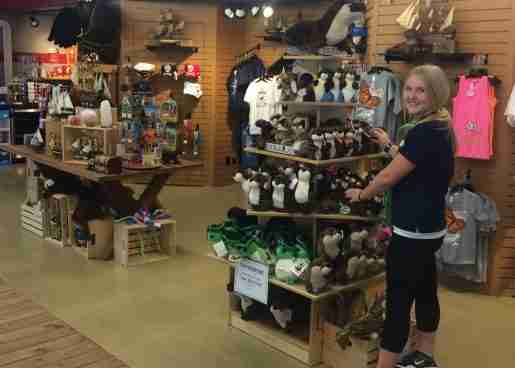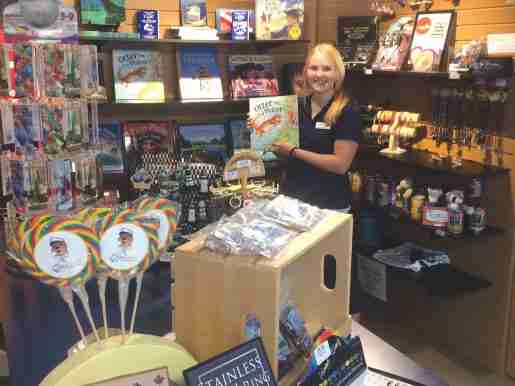Tiny Treasures The Best Small and Inexpensive Souvenirs |
|
|
|
By Karen Appold While visiting zoos and aquariums, customers often seek out small and inexpensive merchandise at the gift shop. In addition to serving as a memento of a visit, these items won’t break the bank and are easy to take home. Colleen Dunlap, gift shop buyer, Austin Zoo, Austin, Texas, said her best-selling small, inexpensive souvenirs are Good Luck Minis from Safari Ltd. “These tiny plastic animals sell for $1,” she said. “Parents are willing to buy one or two for a child to get them to stop asking for the larger items, or will get one and a larger item so the child can have two items.” The large variety of different animals is also a selling point—some customers will buy one of every animal so they can go home with their very own pocket zoo.  Pictured in the Aquatarium at Tall Ships Landing store is Amelia. Mood rings and colored stones are among the small souvenirs best-sellers at the shop. Pictured in the Aquatarium at Tall Ships Landing store is Amelia. Mood rings and colored stones are among the small souvenirs best-sellers at the shop.Four and seven-inch plush sell well at Dakota Zoo, in Bismarck, N.D., reported Anita Morris, gift shop/office manager. “They are well made, cute and soft, and cost less than $10, so they are something a child can spend their allowance money on.” Small glass animals also sell extremely well; people often collect them—buying one each time they visit. The gift shop is approximately 1,100 square feet. Qualities to Seek Out Dunlap looks for items of decent quality—they shouldn’t break within five minutes of handling them. They also need to appeal to a wide range of guests. “If an item also has a practical use, such as the paper fans sold during the summer, that’s great a feature, too,” she said. Vicki Churchman, operations manager, Flint RiverQuarium, Albany, Ga., also seeks out quality items, and also considers price point. “We recently added Clay Critter magnets for $5.99 that are produced in the United States and have our logo,” she said. “Guests frequently request logoed items.” As a small aquarium in a high-poverty area, Churchman emphasized the importance of keeping price points low. “We have very few items that retail for more than $15 to $20,” she said. Morris always requests a sample of a product before ordering it to ensure that it is a quality item. The wholesale purchase price also needs to be reasonable enough.  Katie of the Aquatarium at Tall Ships Landing in Brockville, Ontario, Canada. Breakable merchandise is kept out of the reach of children at the store. Katie of the Aquatarium at Tall Ships Landing in Brockville, Ontario, Canada. Breakable merchandise is kept out of the reach of children at the store.Garnering Attention A corner of the 800-square-foot gift shop at Austin Zoo has an area marked “Everything Under $5.” “This is a handy area to point out to kids on field trips and parents who are looking for an inexpensive souvenir option,” Dunlap said. “We also have the price highlighted on a few less expensive items in order to better catch the attention of customers looking to make an impulse purchase. Impromptu purchases are a great way to sell less expensive items. If you know something is fairly popular, but not something a customer will specifically look for, put it on display right by the register. Customers will often add it to their purchase as you’re ringing up their other items.” Shawne Sheldon, retail manager, Washington Park Zoo, Michigan City, Ind., displays a lot of small items in baskets on a countertop at the 800-square-foot gift shop. She labels the baskets with price tags, to draw people in with the low costs. “Parents can let their kids pick something out and know that the prices will be low,” she said. She’s sure to keep the baskets well stocked. Oftentimes, the merchandise is brightly colored, which garners attention. She tends to place like items together, such as jewelry, candy and so forth.  An eclectic mix of merchandise at Aquatarium at Tall Ships Landing store. Amelia is pictured holding an item. An eclectic mix of merchandise at Aquatarium at Tall Ships Landing store. Amelia is pictured holding an item.Using Caution with Children Bondi doesn’t keep items that are easily broken within easy reach of children. “Parents tend to not pay attention to what their child grabs unless they are the ones giving it to them from the higher shelves,” he said. Morris said most merchandise for children is not breakable or is in packaging that makes it hard to access. Employees keep their eyes on merchandise as much as possible to ensure it doesn’t get damaged. |
